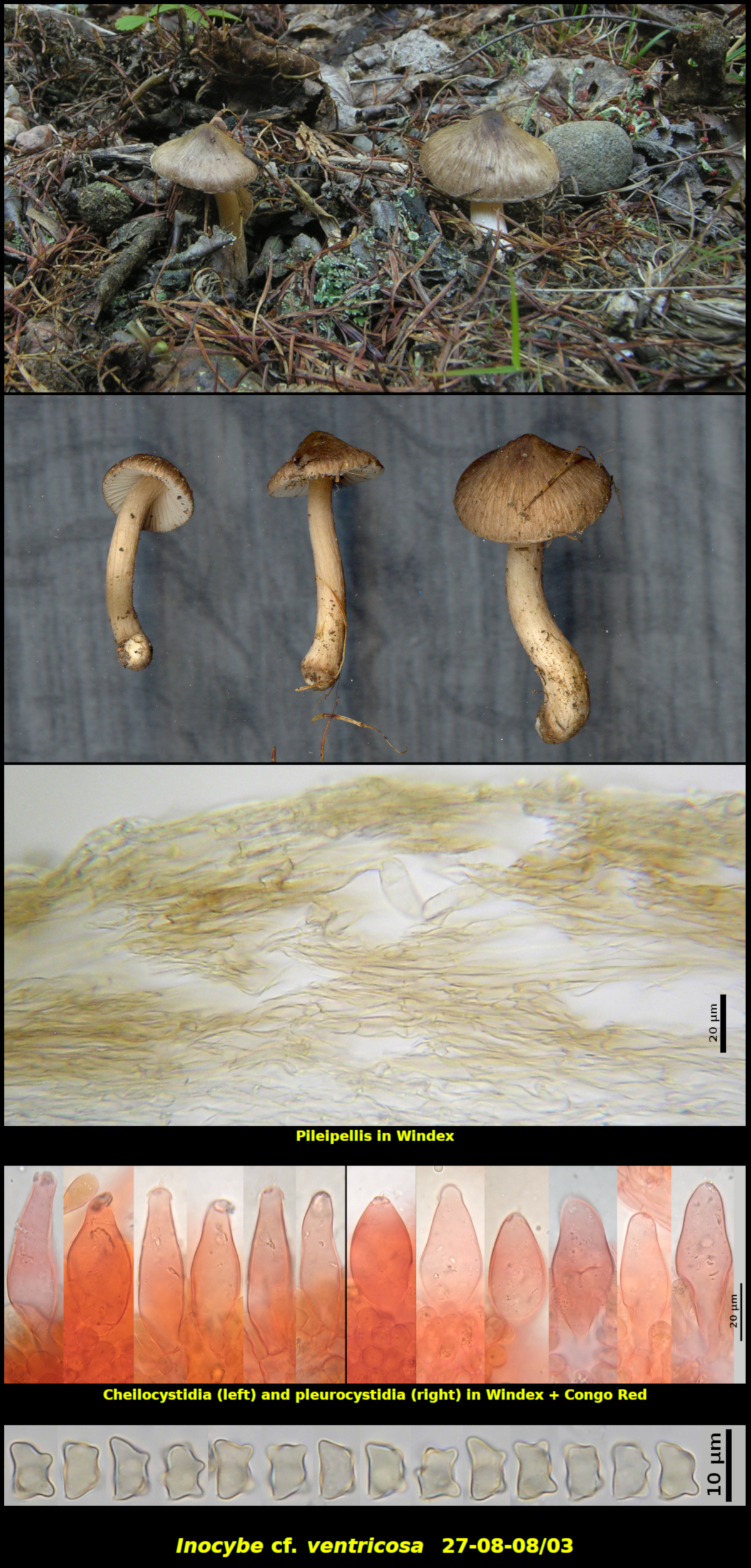Fleshy Fungi of New Brunswick >>
Inocybe cf. aurea
Inocybe cf. ventricosa G.F. Atk.

Gregarious in sandy soil in association with Larix laricina, with a seedling of Abies balsamea nearby, NW of Lepreau, Charlotte Co., New Brunswick,
Pileus conical at first, expanding to more broadly so at maturity, with a fairly sharp umbo, radially silky-fibrillose, not becoming scaly and only faintly rimose at the margin, Brown to Greyish brown (7E3-4), Brownish grey (6C2) toward the margin, 16-21 mm in diameter. Stipe Greyish orange to Orange grey (5B2-3), equal, dry, glabrous and apparently not pruinose, 22-42 X 3-4 mm. Lamellae white, close, adnexed, not marginate. Cortina not seen. Flesh white in the pileus and faintly yellowish white in the stipe, with a faint mushroom odour.
Basidiospores not forming a visible spore print, pale brown in microscopic mounts, strongly nodulose with 7-9 nodules, 7.0-8.9 x 5.1-6.5 μm, Q = 1.09-1.60 (average[41]: 7.8 x 5.8 μm, Q = 1.33). Cheilocystidia abundant, narrowly to broadly ventricose, occasionally slightly lageniform, thin-walled, often with apical crystals, with a basal clamp connection, 44-60 x 13.4-22.2 μm. Pleurocystida abundant and conspicuous, mostly broadly ventricose, commonly broader than most of the cheilocystidia, thin-walled, often with apical crystals, with a basal clamp connection, 43-59 x 17.2-23.7 μm. Pileipellis a cutis of brown radially encrusted hyphae.
The precise identification of Collection 27-08-08/03 is difficult. The appressed-fibrillose and only slightly rimose pileus, thin-walled cystidia and strongly nodulose basidiospores characterize several species of Inocybe. Inocybe parcecoacta differs in having larger basidiospores, a stipe that is peronate below and flesh with a pleasant aromatic odour. Inocybe prominens differs mainly in having a dark brown cap and stipe. Inocybe soluta usually has larger basidiomata, more slender cystidia, smaller basidiospores and usually grows in moist moss-coverd habitats under spruce and fir. Inocybe ventricosa seems to be the closest fit but is characterized by having yellow colours in the pileus and stipe.
The main reservation with calling Collection 27-08-08/03 I. ventricosa relates to the colour of the pileus. Atkinson's orginal diagnosis of the species (Amer. J. Bot. 5: 217. 1918) describes the pileus as being "luteo-ochraceo", a colour not especially close to that of the New Brunswick collection, although it does have a vaguely yellow component. The field description of Methuen 7E3-4 is really more of a dark orange brown, suggesting similarities to I. prominens. However, Atkinson described the stipe of his collection as "luteo-subochraceo", which might be closer to the colour of ours.
Grund and Stuntz (Mycologia 73: 655-674. 1981) reported two collections from Nova Scotia they considered to be representative of I. ventricosa and compared these to Atkinson's type material. Their field notes describe the pileus as "Yellow ochre", Munsell 2.5Y 6/6 at first and then later Methuen 4C4, a dull greyish olive colour. They described the stipes of their material as "pallid yellow to yellowish buff", not unlike ours. Thus Collection 27-08-08/03 falls somewhere between I. prominens and I. ventricosa based on its brown pileus and yellow stipe.
Inocybe aurea is a species similar to I. ventricosa in having a yellow pileus and stipe. The new Brunswick material of Inocybe aurea is a good fit in colour, morphology and ecology to the type and is different from Collection 27-08-08/03 and to Atkinson's description of I. ventricosa.
Photo: D. Malloch (27-08-08/03).